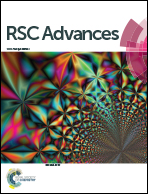First principles study on the structural evolution and properties of (MCl)n (n = 1–12, M = Cu, Ag) clusters
Abstract
The structural evolution of (MCl)n (M = Cu, Ag, n = 1–12) clusters has been explored using a first principles global minimization technique, namely, a genetic algorithm from density functional theory geometry optimization (GA-DFT). Benchmark calculations indicate that the method used in this work is reliable in predicting the energetic sequences of different isomers of (CuCl)6 clusters compared to the high-level coupled cluster method. The computational results indicate that the structures of (CuCl)n and (AgCl)n clusters share many similarities. The global minima of (MCl)n clusters are planar and nonplanar monocyclic structures up to n = 5, and multi-ring or catenane structures when n ≥ 6. The characters of the intramolecular interactions of (AgCl)3, (CuCl)3, (CuCl)4 and (CuCl)6 clusters have been studied by the noncovalent interactions (NCI) index. The electronic and bonding properties of (CuCl)3 and (AgCl)3 clusters are analyzed. At a higher level, the refined energies of the isomers, the binding energies and the second difference of binding energies are calculated, and are examined as a function of the cluster size. Several promising sizes of higher stability and symmetry have been discovered. In particular, we find that the cluster adopts a new folding manner, tube conformation, at n = 6, 9 and 12, where they are more stable than the adjacent clusters; moreover, they are aromatic.


 Please wait while we load your content...
Please wait while we load your content...